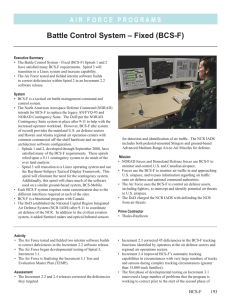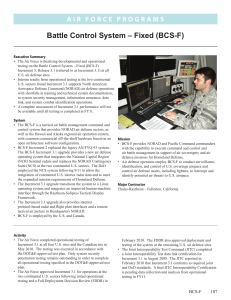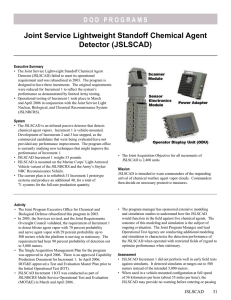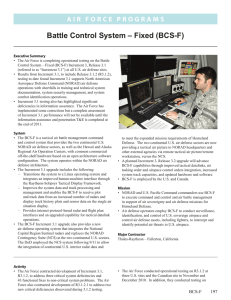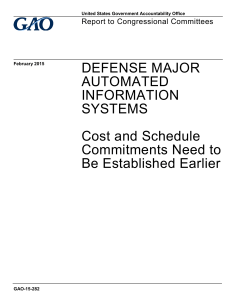Battle Control System – Fixed (BCS-F)
advertisement
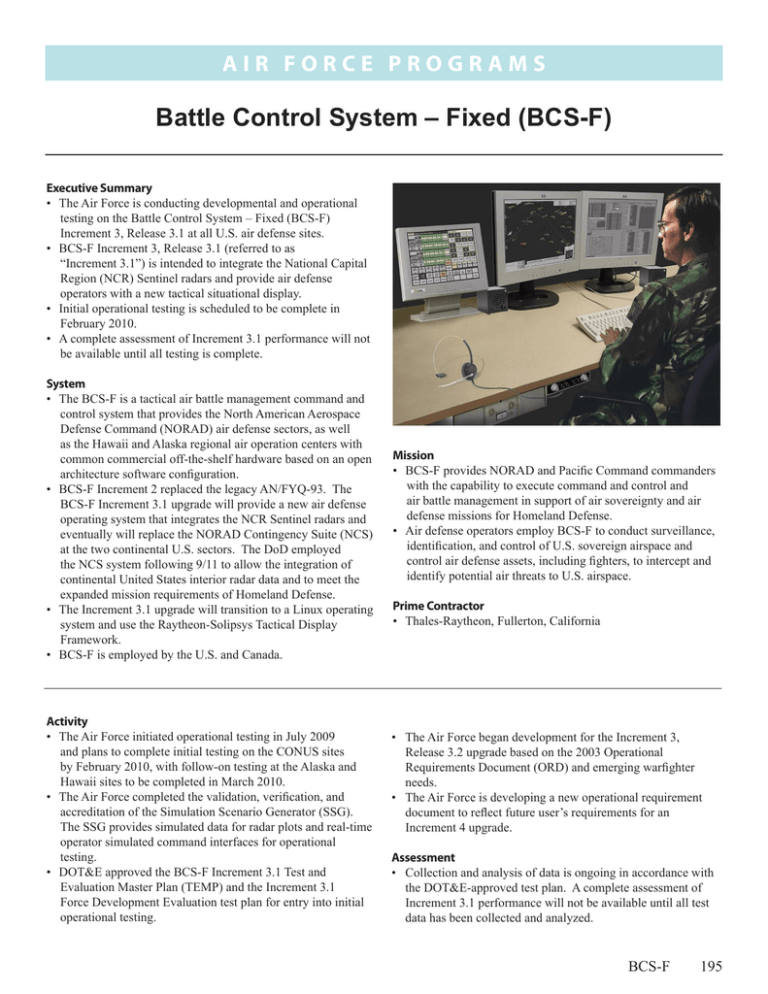
AIR FOR C E P ROGRA M S Battle Control System – Fixed (BCS-F) Executive Summary • The Air Force is conducting developmental and operational testing on the Battle Control System – Fixed (BCS-F) Increment 3, Release 3.1 at all U.S. air defense sites. • BCS-F Increment 3, Release 3.1 (referred to as “Increment 3.1”) is intended to integrate the National Capital Region (NCR) Sentinel radars and provide air defense operators with a new tactical situational display. • Initial operational testing is scheduled to be complete in February 2010. • A complete assessment of Increment 3.1 performance will not be available until all testing is complete. System • The BCS-F is a tactical air battle management command and control system that provides the North American Aerospace Defense Command (NORAD) air defense sectors, as well as the Hawaii and Alaska regional air operation centers with common commercial off-the-shelf hardware based on an open architecture software configuration. • BCS-F Increment 2 replaced the legacy AN/FYQ-93. The BCS-F Increment 3.1 upgrade will provide a new air defense operating system that integrates the NCR Sentinel radars and eventually will replace the NORAD Contingency Suite (NCS) at the two continental U.S. sectors. The DoD employed the NCS system following 9/11 to allow the integration of continental United States interior radar data and to meet the expanded mission requirements of Homeland Defense. • The Increment 3.1 upgrade will transition to a Linux operating system and use the Raytheon-Solipsys Tactical Display Framework. • BCS-F is employed by the U.S. and Canada. Activity • The Air Force initiated operational testing in July 2009 and plans to complete initial testing on the CONUS sites by February 2010, with follow-on testing at the Alaska and Hawaii sites to be completed in March 2010. • The Air Force completed the validation, verification, and accreditation of the Simulation Scenario Generator (SSG). The SSG provides simulated data for radar plots and real-time operator simulated command interfaces for operational testing. • DOT&E approved the BCS-F Increment 3.1 Test and Evaluation Master Plan (TEMP) and the Increment 3.1 Force Development Evaluation test plan for entry into initial operational testing. Mission • BCS-F provides NORAD and Pacific Command commanders with the capability to execute command and control and air battle management in support of air sovereignty and air defense missions for Homeland Defense. • Air defense operators employ BCS-F to conduct surveillance, identification, and control of U.S. sovereign airspace and control air defense assets, including fighters, to intercept and identify potential air threats to U.S. airspace. Prime Contractor • Thales-Raytheon, Fullerton, California • The Air Force began development for the Increment 3, Release 3.2 upgrade based on the 2003 Operational Requirements Document (ORD) and emerging warfighter needs. • The Air Force is developing a new operational requirement document to reflect future user’s requirements for an Increment 4 upgrade. Assessment • Collection and analysis of data is ongoing in accordance with the DOT&E-approved test plan. A complete assessment of Increment 3.1 performance will not be available until all test data has been collected and analyzed. BCS-F 195 AIR FOR C E P ROGRA M S • The program must conduct some developmental and operational testing at the operational sites due to limitations of its test-bed, the System Support Facility (SSF), and the uniqueness of each air defense site. • The legacy ORD does not accurately reflect current and future warfighter needs. Recommendations • Status of Previous Recommendations. The Air Force satisfied the FY08 recommendation of accrediting the SSG and is making progress on the remaining two FY08 recommendations. 196 BCS-F • FY09 Recommendations. The Air Force should: 1. Update the current ORD or accelerate development of a new operational requirement document to accurately reflect current and future user requirements. 2. Upgrade the SSF to support more robust BCS-F developmental and operational testing capability in order to minimize the impact of overall testing on the operational sites. 3. Submit a TEMP for the follow-on BCS-F Increment 3.2.
